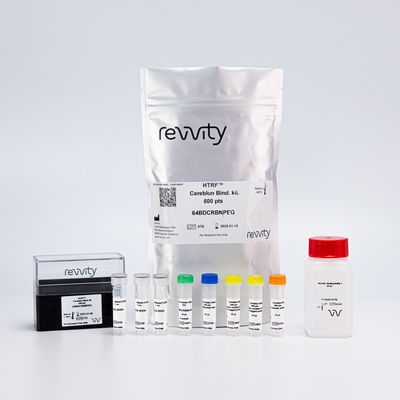

HTRF Cereblon Binding Kit, 10,000 Assay Points


HTRF Cereblon Binding Kit, 10,000 Assay Points






The Cereblon binding assay is designed to screen and characterize compounds that specifically bind the E3 ligase, Cereblon.
For research use only. Not for use in diagnostic procedures. All products to be used in accordance with applicable laws and regulations including without limitation, consumption and disposal requirements under European REACH regulations (EC 1907/2006).
| Feature | Specification |
|---|---|
| Application | Protein-Protein Interaction |
| Sample Volume | 5 µL |
The Cereblon binding assay is designed to screen and characterize compounds that specifically bind the E3 ligase, Cereblon.
For research use only. Not for use in diagnostic procedures. All products to be used in accordance with applicable laws and regulations including without limitation, consumption and disposal requirements under European REACH regulations (EC 1907/2006).



HTRF Cereblon Binding Kit, 10,000 Assay Points



HTRF Cereblon Binding Kit, 10,000 Assay Points



Product information
Overview
A fast and easy way to identify new binders to Cereblon WT protein.
Cereblon, also known as CRBN, is involved in many biological processes and is closely associated with proliferation, apoptosis, cell metabolism, and the occurrence of many diseases. Cereblon is also one of the two most popular E3 ligases which is recruited by bifunctional Proteolysis-targeting chimeras (PROTACs) to induce ubiquitination and subsequent proteasomal degradation of a targeted protein. Cereblon interacts with several proteins to form the functional E3 ubiquitin ligase complex, in which CRBN functions as a substrate receptor of the E3 ubiquitin ligase complex and targets proteins for proteolysis.
Identifying new Cereblon ligands is therefore a way to control biological processes involved in oncology, neurodegenerative, or metabolic diseases by inducing the proteasomal-dependent degradation of undesired proteins.
Specifications
| Application |
Protein-Protein Interaction
|
|---|---|
| Brand |
HTRF
|
| Detection Modality |
HTRF
|
| Product Group |
Kit
|
| Sample Volume |
5 µL
|
| Shipping Conditions |
Shipped in Dry Ice
|
| Target Class |
Binding Assay
|
| Technology |
TR-FRET
|
| Therapeutic Area |
Inflammation
Neuroscience
Oncology & Inflammation
|
| Unit Size |
10,000 Assay Points
|
Video gallery

HTRF Cereblon Binding Kit, 10,000 Assay Points

HTRF Cereblon Binding Kit, 10,000 Assay Points

How it works
Assay principle
The HTRF Cereblon binding assay is a competitive assay format which uses Thalidomide-Red as Cereblon ligand, a GST tagged human Cereblon protein, and an anti GST Cryptate-labeled antibody. Your compound competes with the Thalidomide-Red and thereby prevents FRET from occurring.

Assay protocol
The Cereblon binding assay can be run in a 96- or 384-well low volume white plate (20 µL final). As described here, samples or standards are dispensed directly into the assay plate, the human GST-tagged Cereblon protein is then added followed by the dispensing of the HTRF reagents: the anti GST antibody labeled with Europium cryptate and the Thalidomide-Red labeled with XL665. The reagents labelled with HTRF fluorophores may be pre-mixed and added in a single dispensing step. No washing steps are needed. The protocol can be further miniaturized or upscaled by simply resizing each addition volume proportionally.

Assay validation
Screening of Cereblon orthosteric ligands
Various compounds known to be Cereblon ligands were added to the assay. Lenalidomide (assay standard), pomalidomide, and thalidomide display the right potency and pharmacological ranking in good correlation with the literature. VH032, a non-specific compound, well known as a VHL E3 ligase orthosteric ligand, and Nutlin3a, another non-specific compound, well known as a MDM2 E3 ligase orthosteric ligand, had no effect on the assay, confirming the specificity of the kit for Cereblon binders


Screening of PROTAC compounds (Cereblon-ligand based)
Various PROTAC compounds, known to be PROTAC Cereblon-ligand based, were added to the assay. BSJ-04-132, BSJ-03-123, dBRD9, TL13112, and MT802 display the right potency in good correlation with the literature. AT11 and CM1 , two non-specific compounds, well known to be PROTAC VHL-ligand based, had no effect on the assay, confirming the specificity of the kit in detecting only PROTAC Cereblon-ligand based.


DMSO effect on assay performance
Different percentages of DMSO were tested, from 0.4% to 2% (final in the wells). The results indicate that the assay window is reduced with the increasing percentages of DMSO, while the pharmacology remains stable.

Simplified pathway
Role of Cereblon in the CRL4-CRBN E3 ubiquitin ligase complex
Cereblon, also known as CRBN, is a ubiquitously expressed protein of 442 amino-acids (55 kDa).
CRBN interacts with DNA damage-binding protein-1 (DDB1), Cullin 4 (Cul4), and the regulator of Cullins 1 (RoC1) to form a functional E3 ubiquitin ligase complex. In this complex, CRBN functions as a substrate recognition subunit, and targets proteins for proteolysis through a ubiquitin-proteasome system (UPS). This E3 ubiquitin ligase complex can therefore achieve different cellular responses by targeting different substrates.
CRBN expression in the brain is associated with memory and learning processes. The nonsense mutation (R419X) is responsible for nonsyndromic mental retardation.
CRBN also ensures normal cell proliferation and metabolism by regulating the function of ion channels.
Cereblon is also the primary direct target of the immunomodulatory drugs (IMiDs) Thalidomide, Pomalidomide, and Lenalidomide, that are all FDA approved drugs for the treatment of multiple myeloma. These drugs induce ubiquitination and degradation of the lymphoid transcription factors IKZF1 and IKZF3 via the CRBN E3 ubiquitin ligase.

Resources
Are you looking for resources, click on the resource type to explore further.
This guide provides you an overview of HTRF applications in several therapeutic areas.


How can we help you?
We are here to answer your questions.






























